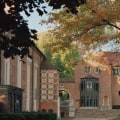Albert Kahn was an American industrial architect who was accredited from Detroit and designed industrial plant complexes such as the Ford River Rouge automobile complex. He also constructed skyscrapers and offices in Detroit. The Booth family, whose son Henry was one of Eliel Saarinen's architecture students, then sought the creation of public buildings specifically focused on the arts and education. Eliel Saarinen (1873-1950) was a renowned architect in Finland when he participated in a competition to design the Chicago Tribune Building in 1922. He won second place and used the prize money to emigrate to Chicago in 1923, accompanied by his wife Loja (1879-196), daughter Pipsan (1905-197) and son Eero (1910-1966).
Soon after his arrival, he was invited to teach architecture at the University of Michigan in Ann Arbor. The Cranbrook campus is famous for its architecture in the Arts and Crafts and Art Deco styles. Eliel Saarinen was the chief architect, while Albert Kahn was responsible for the Booth mansion. The sculptors Carl Milles and Marshall Fredericks also resided for many years in Cranbrook.
The Cranbrook Museum of Art invites viewers to discover relevant and transformative moments in modern and contemporary art, architecture and design. The Cranbrook Academy of Art, one of the leading graduate schools of architecture, art and design in the United States, was founded by George Booth and Ellen Scripps Booth in 1932. Eliel Saarinen formulated the Academy's curriculum and was its first president from 1932 to 1946, directed its Department of Architecture and Urban Design from 1932 to 1950 and designed numerous commissions outside Cranbrook. Even after its official approval in 1932, Saarinen continued to design new campus buildings with student trainees from the Academy. For this reason, the various design objects that emerged from Cranbrook speak of this moment, however skeptical they may be of any rigid design dogma and eager for a kind of sensual, rich and varied way. Furniture and interior designers Florence Knoll and Benjamin Baldwin also left Cranbrook, as did textile designer Jack Lenor Larsen, industrial designer Niels Diffrient, sculptor Duane Hanson, and architects Ralph Rapson and Harry Weese. Several recent Cranbrook alumni have begun to make a name for themselves in New York, particularly in graphic design. During the Saarinens era in Cranbrook, Loja had an equally important career as a textile designer.
Saarinen brought many of his most distinguished teachers to Cranbrook: Carl Milles, who headed the sculpture department; Maija Grotell, the ceramist; Harry Bertoia, the sculptor and furniture designer; Charles Eames, the designer and architect; David Sterling; Jane Kosstrin; Ralph Rapson; Harry Weese; Florence Knoll; Benjamin Baldwin; Jack Lenor Larsen; Niels Diffrient; Duane Hanson. The Oh's Savage chair is far from moderating the prototype of the 1940 organically designed auxiliary chair by Charles Eames and Eero Saarinen which is on display nearby. And the school had a vision: it was both an academy dedicated to the idea of design and a center for teaching specific skills. In the words of design curator and historian Glenn Adamson: “It's the closest thing we've ever had to the Bauhaus.”Eliel Saarinen was born in Rantasalmi, Finland in 1873. In 1904 he won a competition for the design of an important railway station in Helsinki which made him an important figure in Scandinavian architecture. When he participated in a competition to design a new headquarters tower for The Chicago Tribune he won second prize in 1922 which prompted him to visit the United States. For Cranbrook surely more than any other institution it has the right to consider itself synonymous with contemporary American design; the work of its students and teachers did more than anywhere else to focus international attention on the design work being done on this side of the Atlantic. They enlisted Saarinen as chief architect of the campus who eventually designed Cranbrook School for boys (1925-192), Kingswood School for girls (1929-193), Cranbrook Institute of Science (1935-1993), Cranbrook Academy of Art (1925-194) and Cranbrook Museum and Art Library (1938-1944).






